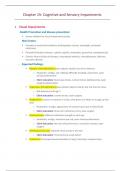Chapter 15: Cognitive and Sensory Impairments
• Visual Impairments
-Health Promotion and disease prevention:
§ Screen children for visual impairments yearly
- Risk factors:
§ Prenatal or postnatal conditions (retinopathy, trauma, meningitis, postnatal
infections)
§ Perinatal infections (herpes, rubella, syphilis, chlamydia, gonorrhea, toxoplasmosis)
§ Chronic illness (sickle cell disease, rheumatoid arthritis, retinoblastoma, albinism,
tay-sachs disease
- Expected findings:
§ Myopia: (nearsightedness) sees objects clearly, but not in distance
o Headache, vertigo, eye rubbing, difficulty treading, clumsiness, poor
school performance
o Client education: biconcave lenses, contact lenses (adolescents), laser
surgery (adolescents)
§ Hyperopia: (farsightedness) sees distant objects clearly, but not that are close
o Not detected until age 7
o Client education: convex lenses, laser surgery
§ Astigmatism: uneven curvatures in vision; only parts of a letter on a page can be
seen
o Headaches, vertigo, appearance of normal vision due to tilted head
o Client education: lenses for refractive errors, laser surgery
§ Anisometropia: different refractive strength in each eye
o Headache, vertigo, excessive eye rub, poor school performance
o Client Education: lens for refractive errors, corrective contact, laser
surgery
§ Amblyopia (lazy eye): reduced visual acuity in one eye
o Client Education: Treat primary visual defect
§ Strabismus: Esotropia (inward deviation of eye); Exotropia: outward eye).
, o Abnormal corneal light reflex, misaligned eyes, frowning, squint, can’t see
print clearly, 1 eye closed to see better, head tilted one side, headaches,
dizziness, diplopia, photophobia, crossed eyes
o Client Education: occlusion therapy (patch stronger eye, remove patch 1
hr each day), laser surgery
§ Cataracts: gray opacity of lens
o Decreased ability to see clearly, loss of peripheral vision, nystagmus,
strabismus, absence of red reflex, infant can’t reach or grab objects
o Client Education: surgery
§ Glaucoma: increase in ocular pressure
o Loss of peripheral vision, halos, red eye, epiphora, photophobia,
blepharospasms, corneal haziness, buphthalmos, pain, red reflex appears
gray to green
o Client Education: surgery
- Diagnostic procedure: Visual screening
§ Snellen letter, Tumbling E, Picture chart (HOTV test) used for preschoolers
§ Partial visual impairment: visual acuity of 20/70 to 20/200
§ Legal blindness: visual acuity of 20/200 or worse or a visual field of 20
degrees or less in the child better eye
§ Peripheral vision: client fixate on an object
o Pencil moves beyond field of vision into rang of peripheral vision
o Normal findings: 50 upward, 70 downward, 60 nasal ward, 90 temporally
§ Color vision: uses ishihara or hardy rand rattler test
o Shown a set of cards and has to identify all #’s on the cards with
correct color
• Hearing impairments
- Health promotion and disease prevention:
§ Screen for hearing impairments
§ Newborns screened after delivery
§ Avoid hazardous noises & wear ear protection in loud environments
- Risk factors:
§ Exposure to loud environmental sounds
§ Pregnancy or labor and delivery factors (anatomic malformation, maternal
ingestion of toxic substances, perinatal asphyxia, perinatal infection)
2
, § Chronic ear infection or ototoxic medications
§ Chronic conditions (down syndrome, cerebral palsy)
- Expected findings:
§ Infants
o Lack of startle reflex -Failure to respond to noise
o Absence of vocalization by 7 months -Lack of response to the spoken
word
o Failure to localize sound by 6 months
§ Older children
o Uses gestures rather than talking after 15 months
o Failure to develop understood speech by 24 months
o Yelling to express emotions
o Irritability due to inability to gain attention
o Seems shy or withdrawn
o Inattentive to surroundings
o Speaking in monotone
o Need for repeated conversation
o Speaking loudly for situation
- Nursing care:
§ Assess child for hearing impairments
§ Promote speech development, lip reading, use of cued speech
§ Use of aids (flashlight when doorbell or phone rings)
§ Refer to support groups
§ Use sign language or interpreter (always talk to child not interpreter)
§ Assess gait/balance
§ Identify safety hazards & adjust environment
§ Assist the use of hearing aids (store batteries in safe place, turn down or adjust
volume if whistle sound is present)
- Therapeutic procedures:
§ Cochlear implants: used for extensive hearing loss; surgically implanted under
skin or worn externally
- Complications:
3




